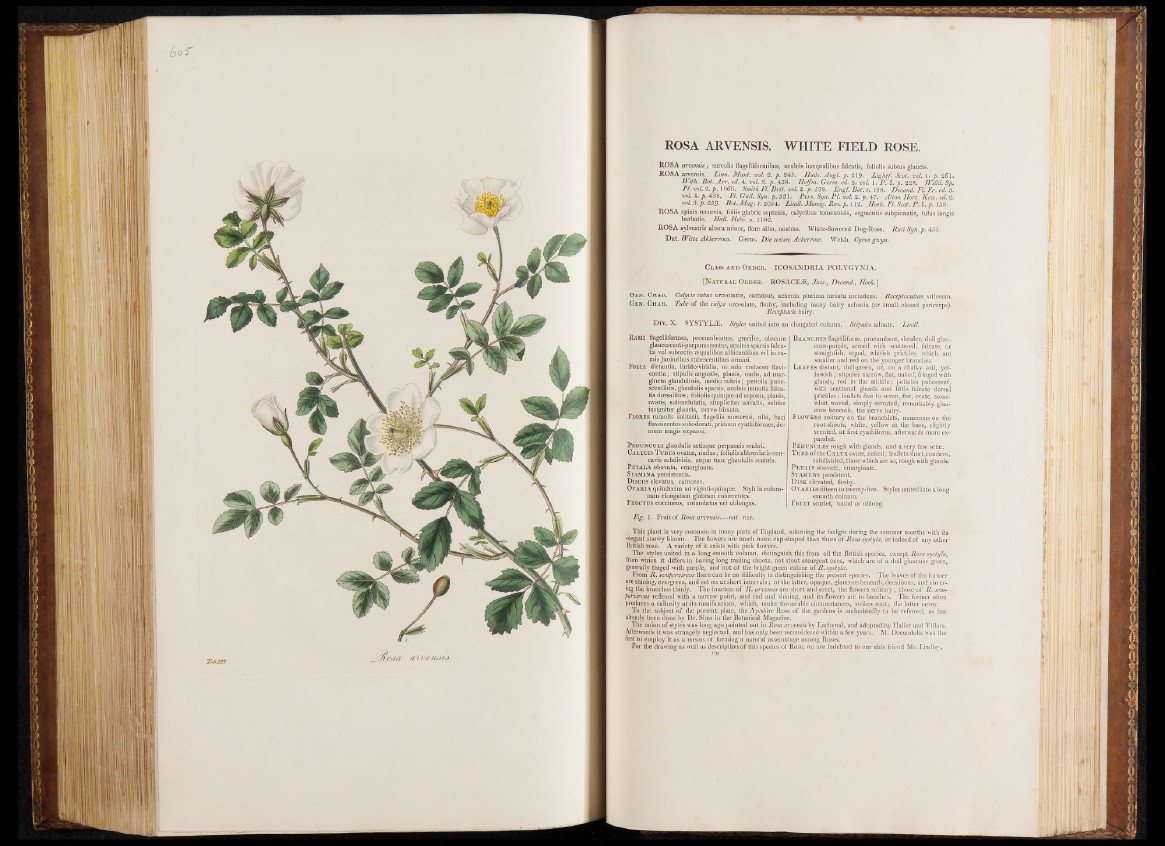
ROSA ARVENSIS. WHITE FIELD ROSE.
ROSA arvensis; surculis flagelliformibus, aculeis intequalibus falcatis, foliolis subtus glaucis.
ROSA arvensis. Linn. Mant. ml. 2. p. 245. Huds. Angl. p . 219. Light/. Scot. ml. I. p. 261.
With. Bot. A rr. ed. 4. ml. 3. p. 458. Hoffm. Germ. ed. 2 . ml. l. P . I. p. 228. Willd. Sp.
PI. ml. 2. p. 1066. Smith FI. B rit. ml. 2. p . 538. Engl. Bot. t. 188. Decand. Fl. Fr. ed. 3.
ml. 4. p. 438. FI. Gall. Syn. p . 531. Pers. Syn. PI. ml. 2. p. 47. Alton Hort. Kern. ed. 2.
ml. 3. p . 259- Bot. Mag. t. 2054. Lindl. Monog. Ros. p . 112. Hook. FI. Scot. P . I. p . 158.
ROSA spinis recurvis, foliis glabris septenis, calycibus tomentosis, segmentis subpinnatis, tubis longis
barbatis. Hall. Helv. n. 1102.
ROSA sylvestris altera minor, flore albo, nostras. White-flowered Dog-Rose. Rail Syn. p. 455.
Dut. Witte Akkerroos. Germ. Die toeisse Ackerrose. Welsh. Gyros gtoyn.
Class a nd Ord e r . ICOSANDRIA POLYGYNIA.
[N atural Ord e r . ROSACEiE, Juss., Decand., Hook.']
Ge n . Cha r. Calycis tubus urceolatus, camosus,. achenia plurima hirsuta includens. Receptaculum villosum.
Gen . Cha r. Tube of the calyx urceolate, fleshy, including many hairy achenia (or small closed pericarps);
Receptacle hairy.
Drv. X . SYSTYLiE. Styles united into an elongated column. Stipules adnate. Lindl.
Rami flagelliformes, procumbentes, graciles, obscure
glaucescenti-purpurascentes, aculeis sparsis falcatis
vel subrectis asqualibus albicantibus vel in ra-
mis junioribus rubescentibus armati.
Folia distantia, lurido-viridia, in solo cretaceo flavi-
cantia; stipulis angustis, planis, nudis, ad mar-
ginem glandulosis, medio rubris; petiolis pube-
scentibus, glandulis sparsis, aculeis minutis falcatis
dorsalibus; foliolis quinque ad septem, planis,
ovatis, subundulatis, simpliciter serratis, subtus
insigniter glaucis, nervo hirsute.
Flores ramulis solitarii, flagellis numerosi, albi, basi
flavescentes subodorati, primum cyathiformes, de-
mum magis expansi.
Pedunculi glandulis setisque perpaucis scabri.
Calycis T ubus ovatus, nudus; foliolis abbreviatis con-
, cavis subdivisis, atque tunc glandulis scabris.
P etala obovata, emarginata.
Stamina persistentia.
Discus elevatus, carnosus.
Ovaria quindecim ad viginti-quinque. Styli in colum-
nam elungatam glabram cohferentes.
Fructus coccineus, rotundatus vel oblongus.
Fig. 1 . Fruit of Rosa arvensis.—nat. size.
Branches flagelliform, procumbent, slender, dull glaucous
purple, armed with scattered, falcate, or
straightish, equal, whitish prickles, which are
smaller and red on the younger branches.
L eaves distant, dull-green,' or, on a chalky soil, yellowish;
stipules narrow, flat, naked, fringed with
glands, red in the middle; petioles pubescent,
with scattered glands and little falcate dorsal
prickles; leaflets five to seven, flat, ovate, somewhat
waved, simply serrated, remarkably glaucous
beneath, the nerve hairy.
F lowers solitary on the branchlets, numerous on the
root-shoots, white, yellow at the base, slightly
scented, a t first cyathiform, afterwards more expanded.
Peduncles rough with glands, and a very few setre.
T ube of the Calyx ovate, naked; leaflets short, concave,
subdivided, those which are so, rough with glands.
P etals obovate, emarginate.
Stamens persistent.
D isk elevated, fleshy.
Ovaries fifteen to twenty-five. Styles united into a long
smooth column; .
Fr u it scarlet, round or oblong.
This plant is very common in many parts o f England, adorning the hedges during the summer months with its
elegant snowy bloom. The flowers are much more cup-shaped than those of Rosa systyla, or indeed o f any other
British rose. A variety of it exists with pink flowers.
The styles united in a long smooth column, distinguish this from all the British species, except Rosa systyla,
from which it differs in having long trailing shoots, not stout assurgent ones, which are of a dull glaucous green,
generally tinged with purple, and‘not of the bright green colour of R. systyla.
From R. semperoirens there can be no difficulty in distinguishing the present species. The leaves of the former
are shining, evergreen, and set on at short intervals; of the latter, opaque, glaucous beneath, deciduous, and covering
the branches thinly. The bractete of R . arvensis are short and erect, the flowers solitary; those of R. semperoirens
reflexed with a narrow point, and red and shining, and its flowers are in bunches. The former often
produces a callosity at its ramifications, which, under favourable circumstances, strikes root; the latter never.
To the subject of the present plate, the Ayrshire Rose of the gardens is undoubtedly to be referred, as has
already been done by Dr. Sims in the Botanical Magazine.
The union of styles was long ago pointed out in Rosa arvensis by Lachenal, and adopted by Haller and Villars.
Afterwards it was strangely neglected, and has only been reconsidered within a few years. M. Decandolle was the
first to employ it as a means of forming a natural assemblage among Roses.
for tire drawing as well as description of this species of Rose, we are indebted to our able friend Mr. Lindle',